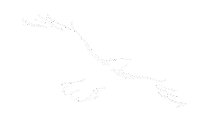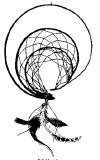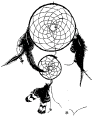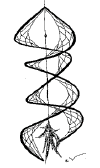The Soul of the Indian
Eastman, Charles Alexander (1911)
A medicine or "mystery feast" was not a public affair, as
members only were eligible, and upon these occasions all the "medicine bags"
and totems of the various lodges were displayed and their peculiar "medicine
songs" were sung. The food was only partaken of by invited guests, and not
by the hosts, or lodge making the feast. The "Grand Medicine Dance" was
given on the occasion of initiating those candidates who had finished their
probation, a sufficient number of whom were designated to take the places of
those who had died since the last meeting. Invitations were sent out in the
form of small bundles of tobacco. Two very large teepees were pitched facing
one another, a hundred feet apart, half open, and connected by a roofless
hall or colonnade of fresh-cut boughs. One of these lodges was for the
society giving the dance and the novices, the other was occupied by the
"soldiers," whose duty it was to distribute the refreshments, and to keep
order among the spectators. They were selected from among the best and
bravest warriors of the tribe.
The preparations being complete, and the members of each
lodge garbed and painted according to their rituals, they entered the hall
separately, in single file, led by their oldest man or "Great Chief."
Standing before the "Soldiers' Lodge," facing the setting sun, their chief
addressed the "Great Mystery" directly in a few words, after which all
extending the right arm horizontally from the shoulder with open palm, sang
a short invocation in unison, ending with a deep: "E-ho-ho-ho!" This
performance, which was really impressive, was repeated in front of the
headquarters lodge, facing the rising sun, after which each lodge took its
assigned place, and the songs and dances followed in regular order.
The closing ceremony, which was intensely dramatic in its
character, was the initiation of the novices, who had received their final
preparation on the night before. They were now led out in front of the
headquarters lodge and placed in a kneeling position upon a carpet of rich
robes and furs, the men upon the right hand, stripped and painted black,
with a round spot of red just over the heart, while the women, dressed in
their best, were arranged upon the left. Both sexes wore the hair loose, as
if in mourning or expectation of death. An equal number of grand
medicine-men, each of whom was especially appointed to one of the novices,
faced them at a distance of half the length of the hall, or perhaps fifty
feet.
After silent prayer, each medicine-man in turn addressed
himself to his charge, exhorting him to observe all the rules of the order
under the eye of the Mysterious One, and instructing him in his duty toward
his fellow-man and toward the Ruler of Life. All then assumed an attitude of
superb power and dignity, crouching slightly as if about to spring forward
in a foot-race, and grasping their medicine bags firmly in both hands.
Swinging their arms forward at the same moment, they uttered their guttural
"Yo-ho-ho-ho!" in perfect unison and with startling effect. In the midst of
a breathless silence, they took a step forward, then another and another,
ending a rod or so from the row of kneeling victims, with a mighty swing of
the sacred bags that would seem to project all their mystic power into the
bodies of the initiates. Instantly they all fell forward, apparently
lifeless.
With this thrilling climax, the drums were vigorously
pounded and the dance began again with energy. After a few turns had been
taken about the prostrate bodies of the new members, covering them with fine
robes and other garments which were later to be distributed as gifts, they
were permitted to come to life and to join in the final dance. The whole
performance was clearly symbolic of death and resurrection.
While I cannot suppose that this elaborate ritual, with
its use of public and audible prayer, of public exhortation or sermon, and
other Caucasian features, was practiced before comparatively modern times,
there is no doubt that it was conscientiously believed in by its members,
and for a time regarded with reverence by the people. But at a later period
it became still further demoralized and fell under suspicion of witchcraft.
There is no doubt that the Indian held medicine close to
spiritual things, but in this also he has been much misunderstood; in fact
everything that he held sacred is indiscriminately called "medicine," in the
sense of mystery or magic. As a doctor he was originally very adroit and
often successful. He employed only healing bark, roots, and leaves with
whose properties he was familiar, using them in the form of a distillation
or tea and always singly. The stomach or internal bath was a valuable
discovery of his, and the vapor or Turkish bath was in general use. He could
set a broken bone with fair success, but never practiced surgery in any
form. In addition to all this, the medicine-man possessed much personal
magnetism and authority, and in his treatment often sought to reestablish
the equilibrium of the patient through mental or spiritual influences -- a
sort of primitive psychotherapy.
The Sioux word for the healing art is "wah-pee-yah," which
literally means readjusting or making anew. "Pay-jee-hoo-tah," literally
root, means medicine, and "wakan" signifies spirit or mystery. Thus the
three ideas, while sometimes associated, were carefully distinguished.
It is important to remember that in the old days the
"medicine-man" received no payment for his services, which were of the
nature of an honorable functionn or office. When the idea of payment and
barter was introduced among us, and valuable presents or fees began to be
demanded for treating the sick, the ensuing greed and rivalry led to many
demoralizing practices, and in time to the rise of the modern "conjurer,"
who is generally a fraud and trickster of the grossest kind. It is fortunate
that his day is practically over.
Ever seeking to establish spiritual comradeship with the
animal creation, the Indian adopted this or that animal as his "totem," the
emblematic device of his society, family, or clan. It is probable that the
creature chosen was the traditional ancestress, as we are told that the
First Man had many wives among the animal people. The sacred beast, bird, or
reptile, represented by its stuffed skin, or by a rude painting, was treated
with reverence and carried into battle to insure the guardianship of the
spirits. The symbolic attribute of beaver, bear, or tortoise, such as
wisdom, cunning, courage, and the like, was supposed to be mysteriously
conferred upon the wearer of the badge. The totem or charm used in medicine
was ordinarily that of the medicine lodge to which the practitioner
belonged, though there were some great men who boasted a special revelation.
There are two ceremonial usages which, so far as I have
been able to ascertain, were universal among American Indians, and
apparently fundamental. These have already been referred to as the "eneepee,"
or vapor-bath, and the "chan-du-hupah-za-pee," or ceremonial of the pipe. In
our Siouan legends and traditions these two are preeminent, as handed down
from the most ancient time and persisting to the last.
In our Creation myth or story of the First Man, the
vapor-bath was the magic used by The-one-who-was-First-Created, to give life
to the dead bones of his younger brother, who had been slain by the monsters
of the deep. Upon the shore of the Great Water he dug two round holes, over
one of which he built a low enclosure of fragrant cedar boughs, and here he
gathered together the bones of his brother. In the other pit he made a fire
and heated four round stones, which he rolled one by one into the lodge of
boughs. Having closed every aperture save one, he sang a mystic chant while
he thrust in his arm and sprinkled water upon the stones with a bunch of
sage. Immediately steam arose, and as the legend says, "there was an
appearance of life." A second time he sprinkled water, and the dry bones
rattled together. The third time he seemed to hear soft singing from within
the lodge; and the fourth time a voice exclaimed: "Brother, let me out!" (It
should be noted that the number four is the magic or sacred number of the
Indian.)
This story gives the traditional origin of the "eneepee,"
which has ever since been deemed essential to the Indian's effort to purify
and recreate his spirit. It is used both by the doctor and by his patient.
Every man must enter the cleansing bath and take the cold plunge which
follows, when preparing for any spiritual crisis, for possible death, or
imminent danger.
Not only the "eneepee" itself, but everything used in
connection with the mysterious event, the aromatic cedar and sage, the
water, and especially the water-worn boulders, are regarded as sacred, or at
the least adapted to a spiritual use. For the rock we have a special
reverent name -- "Tunkan," a contraction of the Sioux word for Grandfather.
The natural boulder enters into many of our solemn
ceremonials, such as the "Rain Dance," and the "Feast of Virgins." The lone
hunter and warrior reverently holds up his filled pipe to "Tunkan," in
solitary commemoration of a miracle which to him is as authentic and holy as
the raising of Lazarus to the devout Christian.
There is a legend that the First Man fell sick, and was
taught by his Elder Brother the ceremonial use of the pipe, in a prayer to
the spirits for ease and relief. This simple ceremony is the commonest daily
expression of thanks or "grace," as well as an oath of loyalty and good
faith when the warrior goes forth upon some perilous enterprise, and it
enters even into his "hambeday," or solitary prayer, ascending as a rising
vapor or incense to the Father of Spirits.
In all the war ceremonies and in medicine a special pipe
is used, but at home or on the hunt the warrior employs his own. The
pulverized weed is mixed with aromatic bark of the red willow, and pressed
lightly into the bowl of the long stone pipe. The worshiper lights it
gravely and takes a whiff or two; then, standing erect, he holds it silently
toward the Sun, our father, and toward the earth, our mother. There are
modern variations, as holding the pipe to the Four Winds, the Fire, Water,
Rock, and other elements or objects of reverence.
There are many religious festivals which are local and
special in character, embodying a prayer for success in hunting or warfare,
or for rain and bountiful harvests, but these two are the sacraments of our
religion. For baptism we substitute the "eneepee," the purification by
vapor, and in our holy communion we partake of the soothing incense of
tobacco in the stead of bread and wine.
THE GREAT MYSTERY -
2
THE FAMILY ALTAR -
2
CEREMONIAL AND SYMBOLIC WORSHIP
-
2
BARBARISM AND THE MORAL CODE
-
2
UNWRITTEN SCRIPTURES
-
2
ON THE BORDERLAND OF SPIRITS
-
2
White Eagle Soaring: Dream Dancer of the 7th Fire







 Get
a course to promote your business online, explode your sales
Get
a course to promote your business online, explode your sales Get
software to promote your business online in less time
Get
software to promote your business online in less time Get
software to streamline your business and run it hands free.
Get
software to streamline your business and run it hands free.